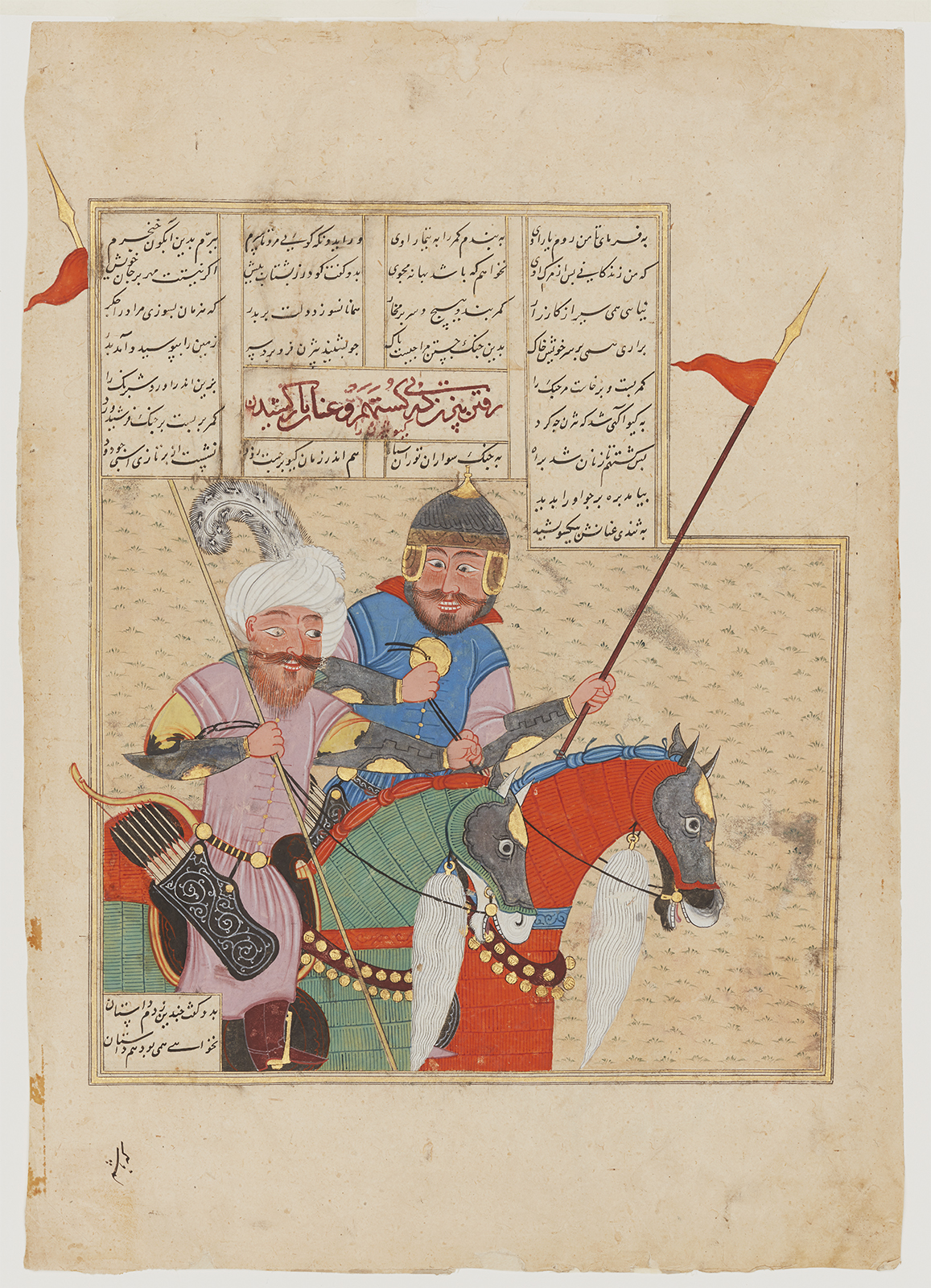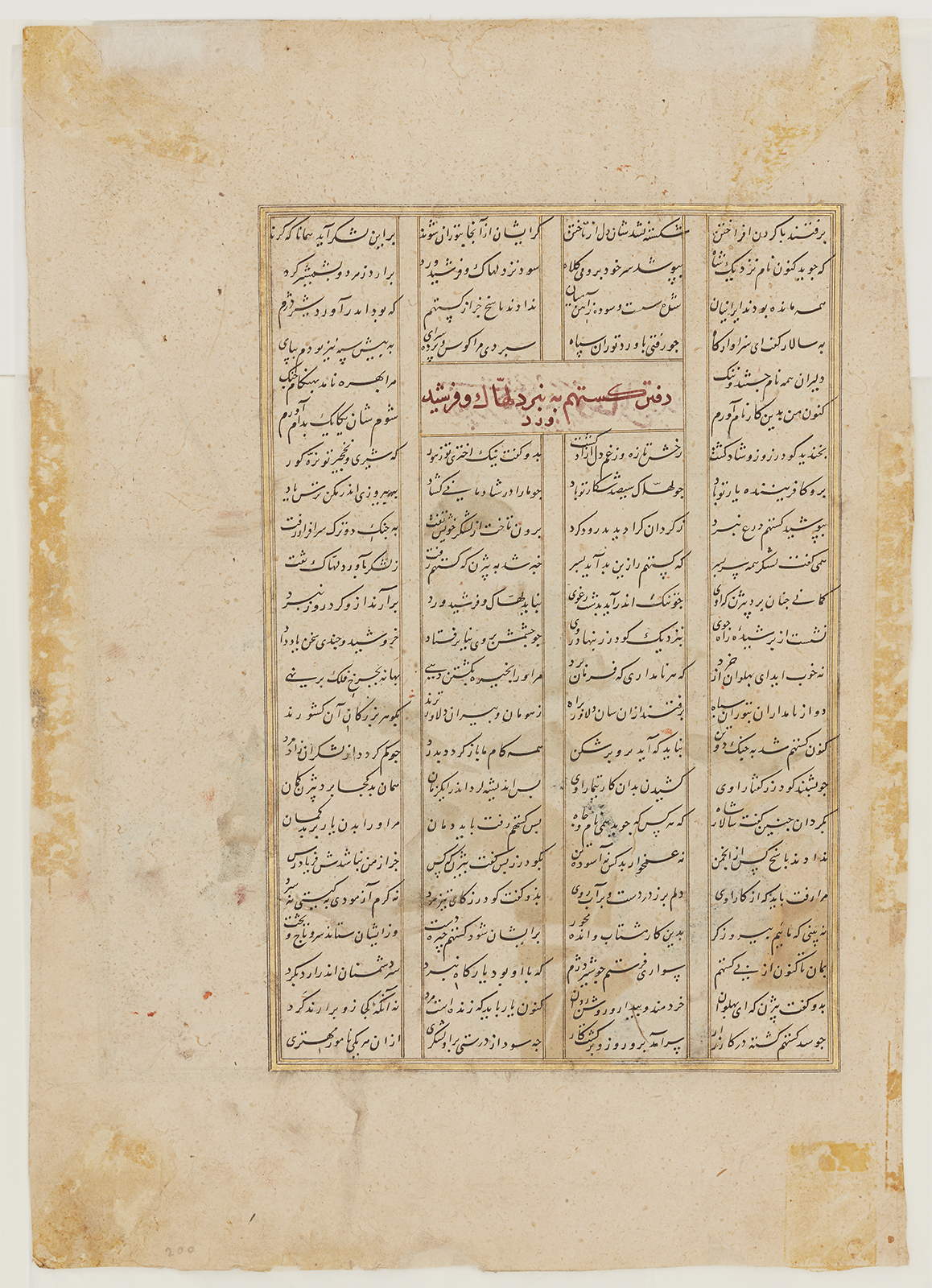Click on the image to zoom
Bijan takes the reins of Gushtaham’s horse
Folio detached from a Shahnameh (Book of Kings) by Abu’l-Qasim Firdausi (d. 1010)
- Accession Number:AKM64
- Creator:Dated 1494, copied by Salik b. Sa‘id, and dedicated to Sultan 'Ali Mirza
- Place:Iran, Lahijan
- Dimensions:34.4 × 24.3 cm
- Date:ca. 1494
- Materials and Technique:opaque watercolour, gold and ink on paper
Recounting the legendary history of Iran’s shahs (kings) up to the Arab conquest in 642 AD and the country’s adoption of Islam, Firdausi’s epic poem the Shahnameh (Book of Kings), completed in 1010, inspired many illustrated copies. The present folio was detached from a copy that is known as the “Big Head” Shahnameh. This name refers to the characteristic feature of the majority of its paintings: the large heads of its human figures.
Further Reading
The “Big Head” Shahnameh is the only known manuscript from the Aqqoyunlu centre and the only surviving manuscript of the Aqqoyunlu period (1378–1501). Originally, it boasted more than 300 paintings. Many of these paintings illustrated subjects that had never been depicted before; for this reason, the “Big Head” Shahnameh contains some newly formulated compositions which closely follow the text.
Depicting only two mounted figures, the present folio represents an incident that takes place after a dozen single combats between Iranian and Turanian warriors. [1] Undertaken to determine the outcome of an inconclusive battle, these confrontations, collectively known as the episode of the “Davazda Rukh” (Twelve Combats), all end in victory for the Iranians. When the slain Turanian commander’s brothers try to escape, however, the Iranian hero Gushtaham pursues and kills them while being wounded himself. The grandson of the Iranian commander, Bizhan, follows Gushtaham and takes him to the Iranian Shah Kai Khusrau. Khusrau saves Gushtaham’s life by tying his own healing armlet around the wounded man’s arm and appointing physicians to tend him.
The illustration captures the moment when Bizhan reaches Gushtaham. It draws attention to the specific instant by representing Bizhan grabbing the reins of the wounded Gushtaham’s horse. In doing so, the illustration is more than a generic battle scene with two mounted figures: it includes a detail which purposely refers to Firdausi’s text.
The “Big Head” Shahnameh is today preserved in two separate collections in Istanbul: volume one, in the Türk ve Islam Eserleri Müzesi (TIEM, ms. 1978, formerly Evkaf, Halet Efendi 3079) and volume two, in the Istanbul University Library (F. 1406, formerly Yıldız 7954/310). The first volume bears a dedication to a Sultan ‘Ali Mirza (TIEM 1978, fol. 1a), while the second volume ends with a colophon which gives the name of the dedicatee as Mirza ‘Ali, as well as the name of the scribe, Salik b. Sa‘id, and the date 899/1494 (IUK F. 1406, fol. 304r). Over 40 illustrated folios from the first volume appear to have been removed and are now found in diverse collections worldwide.
The patron of the manuscript is identified by common consensus in art historical literature as the Shi’ite governor of Gilan, Mirza ‘Ali, from the Karkiya dynasty (r. 1478–1505), whose patronage is otherwise unknown. According to Charles Melville, he is consistently referred to as Mirza ‘Ali in the contemporary sources, as in the colophon of volume two, even though he is called Sultan ‘Ali Mirza in the dedication of volume one, as well as in the secondary literature. [2]
Mirza ‘Ali’s rule covered the crucially important period of the 1501 Safavid takeover of western Iran from the Aqqoyunlu Turkmans (1467–1501). Furthermore, the grandson of the Aqqoyunlu ruler and the future founder of the Safavid dynasty (1501–1724), Isma‘il Safavi, took refuge at the court at Lahijan around the year 1493–94, either just before the beginning or during the production of the “Big Head” Shahnameh. The manuscript thus seems to have been produced and illustrated at exactly the period when the future Safavid shah was at Mirza ‘Ali’s court, which raises the possibility that its creation may be connected to Isma’il’s sojourn in the area.
The Aga Khan Museum has five “Big Head” Shahnameh folios, see AKM62, AKM63, AKM64, AKM91 and AKM92.
— Lale Uluç
Notes
[1] Jules Mohl, ed., Shāhnāma-i Firdausī, 3 vols. (Tabriz: Chapkhāna-i Maharat, 1370/1991), 1: 123, verses 691–700; A.G. Warner and E. Warner, trans., The Shāhnāma of Firdausī, 9 vols. (London: Kegan Paul, 1905–25), 1: 210.
[2] For further reading and all references, see Charles Melville, “The ‘Big Head’ Shāhnāma in Istanbul and elsewhere: Some codicological and iconographical observations,” (forthcoming).
Note: This online resource is reviewed and updated on an ongoing basis. We are committed to improving this information and will revise and update knowledge about this object as it becomes available.




